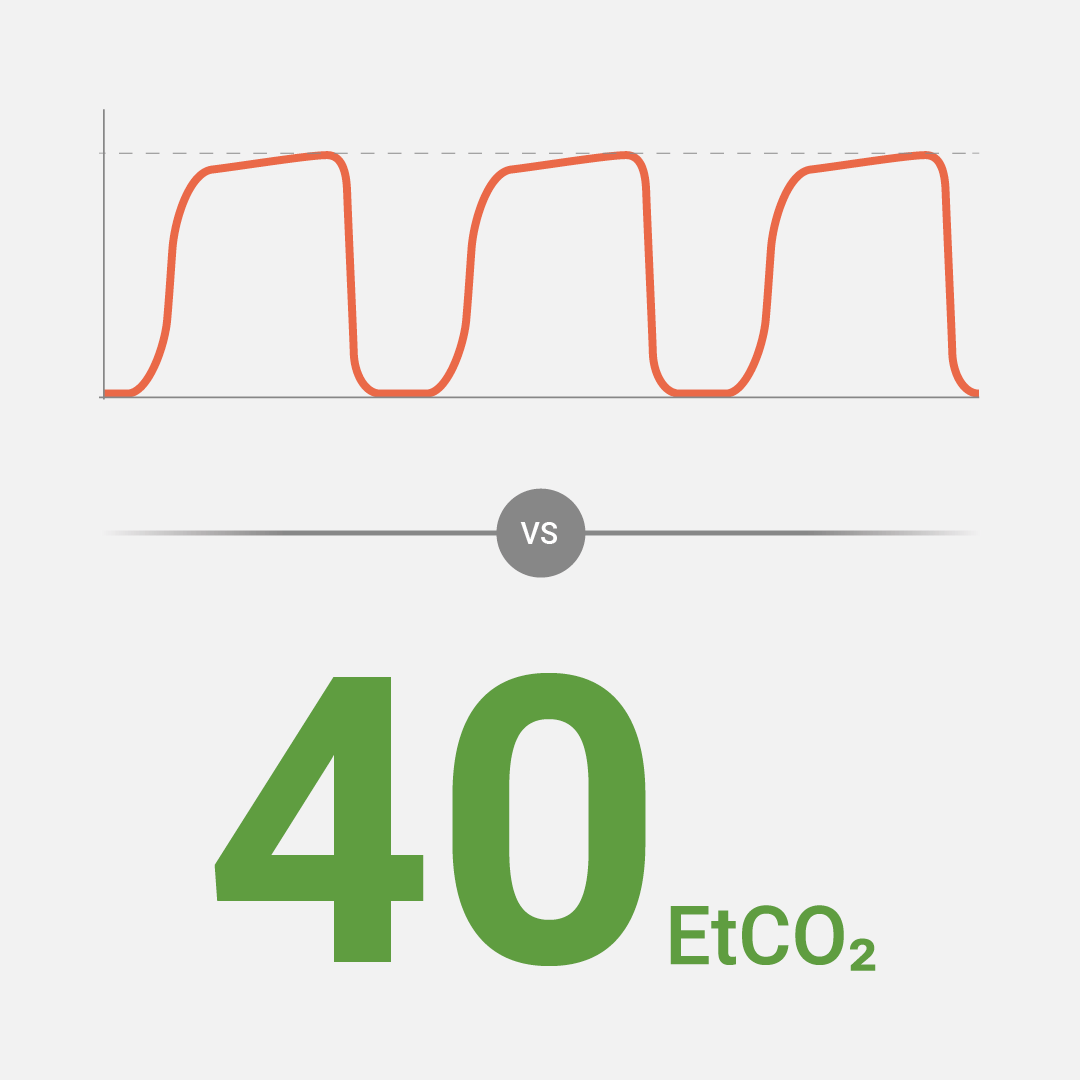What is EtCO₂?
There is a lot of focus on capnography and waveform capnography. Both revolve around End-tidal carbon dioxide (EtCO₂), but what exactly is it? To understand EtCO₂, it is useful to understand the respiratory process.
What is EtCO₂?
End-tidal carbon dioxide (EtCO₂) is the level of carbon dioxide that is released at the end of an exhaled breath. It reflects the adequacy with which carbon dioxide (CO₂) is carried by the blood back to the lungs and exhaled[1].
The Respiratory Process
During the respiratory process, oxygen and carbon dioxide are exchanged, allowing oxygen to be streamlined into the body and for CO₂ to be expelled. CO₂ is critical to our bodies, playing a vital role in regulating blood pH and controlling respiratory drive, as well as the affinity of haemoglobin for oxygen.
Measuring how effectively a patient’s respiratory system is working is essential to ensure the optimum patient outcome. This is where End-tidal carbon dioxide (EtCO₂) is beneficial, as it measures levels of CO₂ in the blood.
Why Measure CO₂?
Measuring CO₂ levels indicates how effectively the respiratory system is working and can help Healthcare Professionals to diagnose patients. During the respiratory process, the brain monitors the pH levels of blood. CO₂ levels have a direct correlation with blood pH levels so the higher the CO₂, the lower the blood pH. Our bodies react to the drop in blood pH by altering our breathing to ensure we can increase our oxygen levels. Clinicians are able to monitor this process by monitoring EtCO₂.
How can EtCO₂ be Used?
Measuring EtCO₂ is incredibly useful to HCPs and has many different uses to help improve patient care and outcomes[2].
EtCO₂ is commonly measured via capnography. Capnography can be used anywhere, but is most commonly used in operating rooms to monitor patients undergoing sedation. It also has other indications, such as measuring cardiac output or monitoring patients in a pre-hospital setting.
Procedural Sedation and Analgesia
EtCO₂ can safely monitor patients during procedural sedation and analgesia. People receiving anaesthesia must be carefully watched during and after sedation, because the medicines used affect the central nervous system, cardiovascular system, and respiratory system[3]. This can affect the brain’s ability to monitor CO₂ levels in the blood and therefore may change how the brain alters a patient’s respiratory system. Due to this, the Association of Anaesthetists (AoA) recommends that patients recovering from sedation are monitored via capnography.
Capnography is a method of measuring EtCO₂ to assist in diagnosing early respiratory depression. This method shows impaired airway function sooner than any other device, including 5 to 240 seconds quicker than pulse oximetry. This can reduce serious complications[4].
You can find out more in our article ‘What is Capnography?’
Monitoring Acute Respiratory Disease
EtCO₂ monitoring can provide insight into respiratory effectiveness, breath by breath, to monitor acute respiratory diseases such as asthma, chronic obstruction pulmonary disease (COPD) and bronchiolitis.
Capnography monitors use sensors with radiation to monitor patient’s EtCO₂. This gives an accurate visual and numerical representation of the patient’s respiratory system, alerting HCPs when levels of EtCO₂ are either too high or too low, allowing them to intervene and adapt the patient’s care to improve their respiratory rate. Measuring EtCO₂ is especially vital in high-risk patients, where respiratory differences can be fatal.
Cardiac Monitoring
EtCO₂ concentration is a reliable index of effective heart compression during CPR, which is associated with cardiac output[5] . It can be used to determine how well CPR is being delivered and also predict if there will be another cardiac arrest or event.
When levels of EtCO₂ are high during chest compressions, above 15 mm HG, it indicates that perfusion is being generated. The higher the level of EtCO₂, the better the perfusion being generated and the better the chances of survival. On the other hand, if EtCO₂ levels are low during compressions, at 10 mm HG, it could point towards a poor compression technique[6].
The first sign of a return to spontaneous circulation (ROSC) is an increase in EtCO₂, which is why it is so important because it provides valuable information to guide those performing CPR[2]. In fact, it is more sensitive than cerebral oxygen saturation (rSO2) in ROSC prediction[7].
Once a patient has been stabilised after CPR, EtCO₂ can also be used to monitor their likelihood of another cardiac incident, This is extremely important as patients with ROSC are at high risk of rearrest for 10 minutes after the event[8].
With ventilation at the appropriate rate, a steady decline in EtCO₂ indicates that CPR may soon be needed or that a vasopressor is needed to support blood pressure. But, if the EtCO₂ is abruptly lost, it may be caused by rearrest or displacement of the advanced airway.
How is End-tidal CO₂ Measured?
The most effective method of measuring CO₂ is through waveform capnography, a non-invasive measurement during inspiration and expiration of CO₂ from the airway. It provides physiological information on ventilation, perfusion, and metabolism, which is important for airway management. Capnographs provide real-time results. This allows HCPs to react quickly to any abnormalities.
See our article ‘What is Waveform Capnography?’ to learn more.
What Should the Level of EtCO₂
be?
The average values of EtCO₂ are 5% to 6% CO₂, which is equivalent to 35-45 mmHg. Anything outside of this range requires investigation.
What Causes Abnormal EtCO₂
Readings?
Abnormal readings could be caused by respiratory issues such as loss of alveolar plateau, bronchonstriction, asthma, hypoventilation or hyperventilation.
You can find out more about reading abnormal capnographs on our ‘What is Waveform Capnography?’ page.
Capnomask™ is a medium concentration mask EtCO₂ monitoring. It was designed alongside clinicians to enable accurate detection of EtCO₂ and enhance patient safety. The high performance Capnomask™ is impregnated with a subtle vanilla scent to help reduce post-operative nausea and vomiting.
You can read more about the features and benefits of Capnomask™ here.
